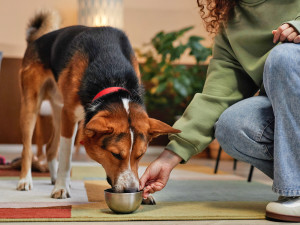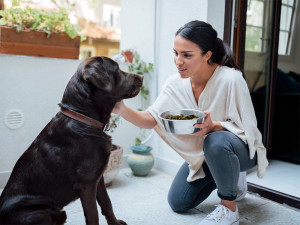When Can a Puppy Eat Solid Food?
Yes, a question that also applies to human babies.
In This Article:
When Can Puppies Eat Solid Food? Choosing the Right Solid Food for Puppies How to Wean Puppies to Solid Food
Introducing solid food to your puppy is exciting and makes for some adorable photos. It’s also important to do so at the right age to maximize healthy growth and development. While puppies can start eating solid food around four weeks old, it’s crucial to gradually transition them from nursing to solids.
Puppies will be ready to be introduced to solids around three or four weeks old. Keep your expectations low at first, as this is a big change for them and at first, they may end up wearing more food than actually eating it. There are many important reasons to gradually transition them to solid foods and to allow them to continue nursing over another few weeks.
When can puppies eat solid food?
While you can introduce solids around four weeks old, puppies need to continue to get the bulk of their nutrients from mother’s milk until they are a bit older. At first, you may notice the puppies aren’t actually eating much of the solid food but over a few weeks they will adjust to the taste and texture of the food and will start to eat more and more.
How much do you spend on your pet per year?
Here are some important considerations to keep in mind:
Age and weight guidelines
Newborn puppies need to get all of their nutrients from milk. Nursing provides them with a complete and balanced diet as well as important immune factors that protect them until their own immune system matures. Orphaned puppies who cannot nurse will need to be bottle-fed a specialized puppy formula instead.
If you weren’t there when your puppy was born, their age can be estimated based on certain developmental milestones including when their eyes and ears open (by about 14 days old) and when their first teeth emerge (around three to four weeks old). Weight is not a reliable guideline for aging puppies since different breeds grow at very different rates. Once a puppy has some puppy teeth, they can start trying out some very mushy solid food.
Breed-specific considerations
Because different breeds grow at such different rates, it is hard to create universal guidelines that make sense for every dog from Chihuahuas to Great Danes. Small breed dogs will generally be smaller puppies, and they will reach their full adult size much earlier than large-breed dogs.
These factors also influence which dog foods are most appropriate for different breeds. Large breed dogs that have a longer period of growth need special puppy food to prevent certain bone disorders. Small breed dogs also have much smaller stomachs and cannot eat very much at each feeding. They will need a more frequent feeding schedule to prevent episodes of low blood sugar, or hypoglycemia.
Gradual transition process
Weaning, which is the process of transitioning puppies from nursing to solid foods, should be done gradually for both physical and behavioral health reasons. Mother’s milk provides the best source of nutrition for puppies, so it is very important that they continue to nurse while they get used to eating solid foods. In addition to the nutrition nursing provides, this time with their mothers and litter mates is very important for their social development, too.
Mother dogs provide important nurturing and care for all of their puppies’ needs, while also teaching them how to be dogs and how to read other dogs’ body language. Their littermates also provide their early socialization experiences, helping them learn how to play and keeping them in line if they get too rough.
Many studies have confirmed that sudden weaning, as well as early weaning, can have negative effects on puppies’ health and long-term behavior. Whenever possible, puppies should be weaned slowly from four weeks old until about eight to ten weeks old to allow for a gradual transition.
Of course, in reality, circumstances are often different, such as when a puppy is found without a mom or needs to be separated for medical reasons. In these cases, they will need to be bottle-fed formula exclusively for the first four weeks of life. Then, they can be slowly transitioned to solids in a similar fashion by decreasing how much formula they drink and slowly increasing the amount of solid food over many weeks
Developmental milestones and readiness signs
Puppies are born toothless and with their eyes and ears closed. Over the first four weeks of life, they have many important developmental milestones. Their eyes usually open between 10 to 14 days old and then their ears open around 12 to 14 days old. By around three weeks old, they should be stumbling around and slowly figuring out how to crawl and walk. Puppy teeth start erupting between three to five weeks old. All of these milestones set them up to be ready to try their first licks of solid food.
Choosing the right solid food for puppies
When it comes to selecting the first solid food for your puppy, there are some important points to keep in mind:
Age-specific formulas
Be sure to select a food that is labeled specifically for puppies, or for growth and reproductive stages. This ensures that the food is formulated to be higher in calories and more dense in nutrients to support the rapid growth and energy needs of a puppy. Since different breeds mature at different rates, you should consult with your veterinarian as to when to transition your puppy to adult food.
For some breeds, they may reach their full adult size by about one year old,while some larger breeds may continue growing until 18 to 24 months old. You’ll want to switch to adult food once your puppy stops growing since they will no longer have such high energy needs and could be at risk for weight gain if they continue eating the higher calorie puppy food.
Quality protein sources and balanced nutrients
Whenever possible, feed your puppy the highest quality diet that you can find. Puppies have very unique nutritional needs so it is important to stick with commercial diets that are specifically formulated to meet a puppy’s needs. It can be confusing to try to analyze ingredients and food labels for pet food, so be sure to consult your vet if you are unsure which foods are best.
Small breed versus large breed considerations
Large-breed puppies experience intense growth over a short period of time. If they eat diets that are not properly balanced for them, they can be at risk for rapid weight gain as well as abnormalities in their bone growth and development. Large and giant breed puppies should eat a diet specifically formulated for large breed puppies which typically has restricted calcium and phosphorus levels.
An updated AAFCO requirement now mandates that all dog foods specify if they are appropriate for dogs expected to be over 70 pounds when full-grown, making it easy to determine if the food is appropriate for large breed puppies.
On the other end of the spectrum, small breed dogs are also extra small puppies. It will be important to keep this in mind when selecting foods to ensure their diet is calorie dense to allow them to meet their needs while eating a smaller quantity of food. Also, if you are selecting kibble for a small breed puppy, be sure to choose a small kibble that will be easy for them to chew. You may have to soak kibble in water at first to soften it and make it easier for your puppy to manage.
How to wean puppies to solid food
It is important to keep in mind that weaning puppies is a gradual process and it will take time for them to adjust to the transition. In the meantime, be prepared for some messy and adorable first attempts at eating solids, and have your camera ready. Here are some helpful tips:
Gradual transition process
Remember this should be a slow transition. Expect that the first few days to weeks of offering solids will be more about the puppies exploring the food, dancing in it, and spilling it, than actually eating it. That’s OK. It’s part of how they try new things and learn. During this time, they still need to get the bulk of their nutrition from either nursing or bottle- feeding.
Mixing solid food with puppy milk
For the first week or two of offering solids, make the food into a very liquidy gruel that will be easy for the puppies to lap up. You can do this by mixing the food with either a small amount of warm water or puppy formula. Offer small amounts in a shallow dish or pan that they can easily access without falling in.
Monitoring acceptance and adjusting consistency
Monitor your puppies closely during the weaning period. Even under ideal circumstances, this can be a stressful time in their development. Weighing them daily can help ensure they are getting enough nutrients and continuing to grow consistently.
Also monitor their general enthusiasm for the new food and watch for any adverse effects like vomiting or diarrhea. Be sure to contact your vet if any concerns arise. If the puppies are eating well, you can gradually make the food less liquid-y to allow them to practice chewing the food and adjusting to the normal texture of the food. Dry kibble may be too hard for young puppies to eat even at six to eight weeks old so you may have to soften it with warm water until they can chew it more easily.
Troubleshooting tips
Puppies have such different personalities, so it’s hard to predict what challenges you may encounter as you wean your puppy to solid foods.
Some helpful tips to keep in mind include:
Separate puppies during feedings: If you are weaning more than one puppy, try separating the puppies from one other for short periods around feeding time. This will help you keep track of which ones are eating well and which ones may need more support. It will also prevent more pushy pups from crowding out their littermates.
Weigh puppies daily: Be sure to keep track of your puppies’ weights during the weaning process. This is a very reliable way to ensure they are eating enough and growing. You may need to purchase a small gram scale or baby scale in order to record accurate weights.
Seek veterinary attention early for any concerns: Any puppies who are not gaining weight or having signs like vomiting, diarrhea, and /or lethargy, should be seen by a vet right away. When they are so young, they are more vulnerable to dehydration, low blood sugar, and other complications of illness, so they need medical attention right away.
FAQs (People also ask):
When do I feed puppies solid food?
Puppies should be introduced to solid foods around four weeks old. You can use certain developmental milestones to help you estimate their age if you are not sure exactly how old your puppy is.
What is the best puppy food for solid stools?
The best food for solid stools will vary from one puppy to another so you may have to try a few to see what works best. Always do a gradual transition from one food to the next and if your puppy has ongoing soft stool or diarrhea, be sure to speak with your vet about other likely causes.
How to wean puppies to solid food?
Weaning is a gradual process over many weeks. At first, introduce very mushy solid food that is mixed with warm water or puppy formula to make a liquidy gruel. Puppies will slowly start to adjust to the taste and texture of the food and over the next few weeks, you can make it less watery and offer more solids as they slowly decrease how much they are nursing.













